June 16th 2023, Jasper, Alberta.
When I left Nelson, I had a choice: go directly north west and re-join my original, if somewhat notional, route north from Vancouver — which was pretty much direct to the Yukon, to Whitehorse, then Dawson City and then left, as it were, into Alaska. Or, I could go east and experience the Canadian Rockies and then head north via a westward diagonal across British Colombia to Whitehorse and on as originally planned. Little contest really; I mean, how could I come this close and not do the Rockies?
The road thus from Nelson first goes south past my friends at the Sweetgrass cannabis farm before turning east and, hugging the border with the United States, until it goes up and over the Kootenay Pass. Along the way, the air is filled with small white flecks of what look like dandelion seeds, so much so that it appeared to be snow falling. I asked someone about this later and they told me it came from cottonwood trees and is indeed a seed dispersal. The journey from Nelson and up the Pass is the start of several days of epic vistas that once again. stop me in my tracks. One after another, they come, and then another and another again. The views are breathtaking and every time I say to myself, “you can’t keep stopping to take a photograph every time there’s another great view”, I scold myself and vow to crack on and stop stopping. And within a few hundred meters, I’m at it again. I can’t help myself. The result is that my phone now has over 12,000 pictures in it — all but a handful from this trip!
Riding up the pass, the fir and spruce tree begin to thin out and sheets of rockface take over the landscape. Coming down towards me are quite a few logging trucks — always a truck laden and pulling a fully loaded trailer, and moving slow downhill in a low gear. At the top of the pass (and its only 1,774 meters above sea level), there’s a quite a large flat wide area, maybe the size of a dozen of football pitches. There’s a log cabin, a real log cabin, by the side of a small lake that is surrounded by pine trees. Truckers stop here and check their breaks before the descent. I stop too but only to look at the lake and watch some small birds chase a larger one, a bird of prey maybe the size of a herring gull that appeared to have a creamy white breast and underbelly. I think it might have been an osprey.
The road comes down into a town named Creston, just east of which is a timeline. I have a late breakfast in a diner, Ricky’s All Day Grill. “Oh yes,” says the waitress, Jennifer, “down that road there, it’s already one o’clock.” It was coming up to 12 noon and I was about to lose an hour. Still, I thought, I get it back when I turn west again and cross back over the line. Or does it not work that way? Jennifer was from New York but had been living in Canada since she was eight. She pointed out places of interest on the map when I told her where I was going. “I want to go to Alaska with a dog and see no one,” she said. I asked her why. “It’s just the last of the wild land,” she said. “Untouched. Rivers. Bears. I wanna go there.”
I crack on and shortly cross a bridge and a sign announces Irishman’s Creek and I feel I have to stop and try to find out what’s the story behind that. It has to have been called that for a particular reason. There’s only one house, so far as I can make out, and I ride into their back yard, a large expanse that looks like it could have had some commercial role, a fuel depot or garden centre maybe. Stopping the bike, it’s clear I’m actually in someone’s back garden: the rear of the house has a table and chairs patio and has the look of a space that’s used. A car is parked with all its doors open, as though someone is loading, or unloading, it. There’s a dog who makes a few half-hearted barks at my arrival. I learn later that he’s named Radar.
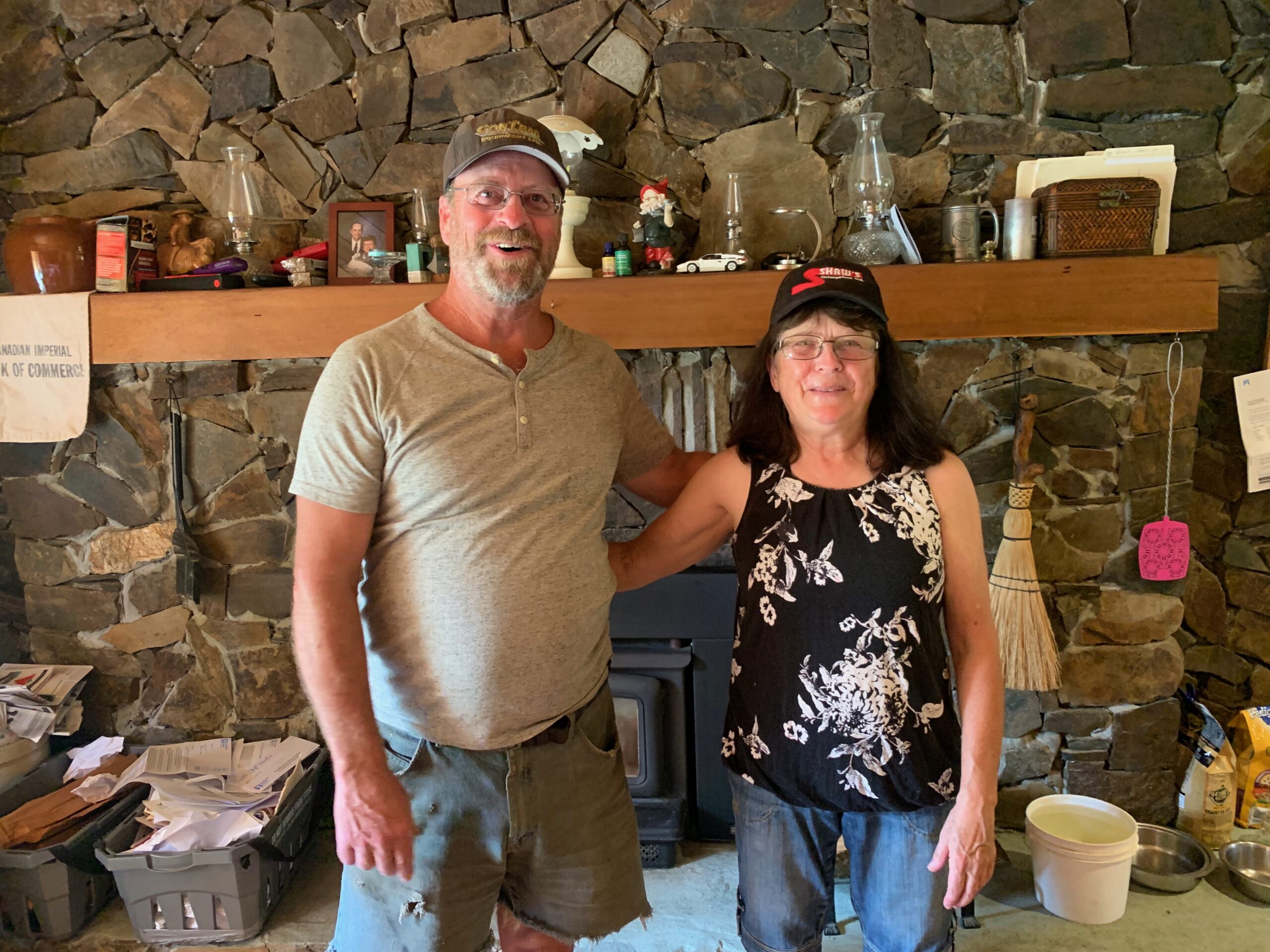
A man emerges from the house, which is built of logs, and I explain myself. His name is Ben Ruest and soon his wife, Julie, joins us. Ben has no idea why the area is called Irishman’s Creek but he leads me back, away from the house, so we have a good view over it the mountain that it faces, across the other side of the road. He points to a small valley high up the mountain and says that’s the start of Irishman’s Creek and then to another small valley to its left. “That’s colean creek,” he says, pronouncing it “co-lean.” That sounds very like cailín, I say, which is the Irish word for a young girl. Small streams in both valleys descend the mountain and merge near the bridge I just crossed.
Ben is originally from Saskatchewan and tells me he’s been living in the house for 35 years. It comes with 167 acres and he gives me a tour of his garden. He takes great pride in several kiwi plants that are coming on well, plus eight raised beds all planted up with vegetables and a greenhouse full of tomato plants. In the adjoining field, there’s one of those tall, slender metal frame, pyramid-shaped structures with a wheel on top that catches the wind and pumps water up from way down below. Ben built it and takes great pride in the fact that it works. On the paddle blade at the top, the one that turns the wheel into the wind, there the maple leaf flag of Canada painted bright red and white, and a also shamrock. In his time, he’s done logging and some farming (he’d like to get some sheep and maybe a few beef cattle) but spent much of his career as an oilman.
“You remember all those fires in Kuwait back in 1991,” says Julie. I say, yes, I do. “Well he was on the Canadian team that went in there to put them out.”
Ben tells me about the house, into which I am invited. It’s a real log house. The logs are D cut logs, which means three sides have been cut flat and straight, while the fourth side remains curved, the way it was when it was when a tree. So, when stacked one on top of the other, with the curved side facing out, you get your log cabin look, while inside, you have a smooth surface and the join between the stacked logs is flat and provides a good seal. The house deeds date from 1916 and it used to be a destination point. “It was run by two negro women, Midge and Marie,” he says. It was a petrol station and a photo they have shows a sign on the building that says simply “Dine Dance”. People from other settlements nearby would drive out to Irishman’s Creek and make a night of it, apparently.
Ben explains: “The old girl had lots of chickens out back and she’s pull the head of a chicken and get some bootleg whisky and they’d have a right old time . . . So why it’s called Irishman’s Creek beats me.”
I ride on (still unknowing why it’s called Irishman’s Creek), amazed — once again — at how easy people are, how friendly when approached, unannounced, uninvited and out of the blue. They’ll take you into their home and tell you about themselves with great openness and be generous with their stories. A little further on, the roads hugs a river, a wide fat lazy river, brown and not the milky blue-grey of the mountain rivers, tumbling down off glaciers, snow and rocks. Next stop for me is a gas station where three fellows from Saskatchewan, Nick, Adrian and Curtis, are giving themselves and their Harleys (two Road Kings and a Dyna Wide Glide) a rest. We chat a bit and then they head off and another fellow is inspecting my bike. He’s unusual looking: he’s wearing a plaid shirt, dark workman’s trousers held up by wide braces, and a pair of boots that ride up over the ankles and half way up his calves but are only half laced, so the tops of the boots are flapped open. He’s about 20 and would not look out of place were he to have been included in the background of that renowned painting of 1930s mid-west farming, American Gothic.
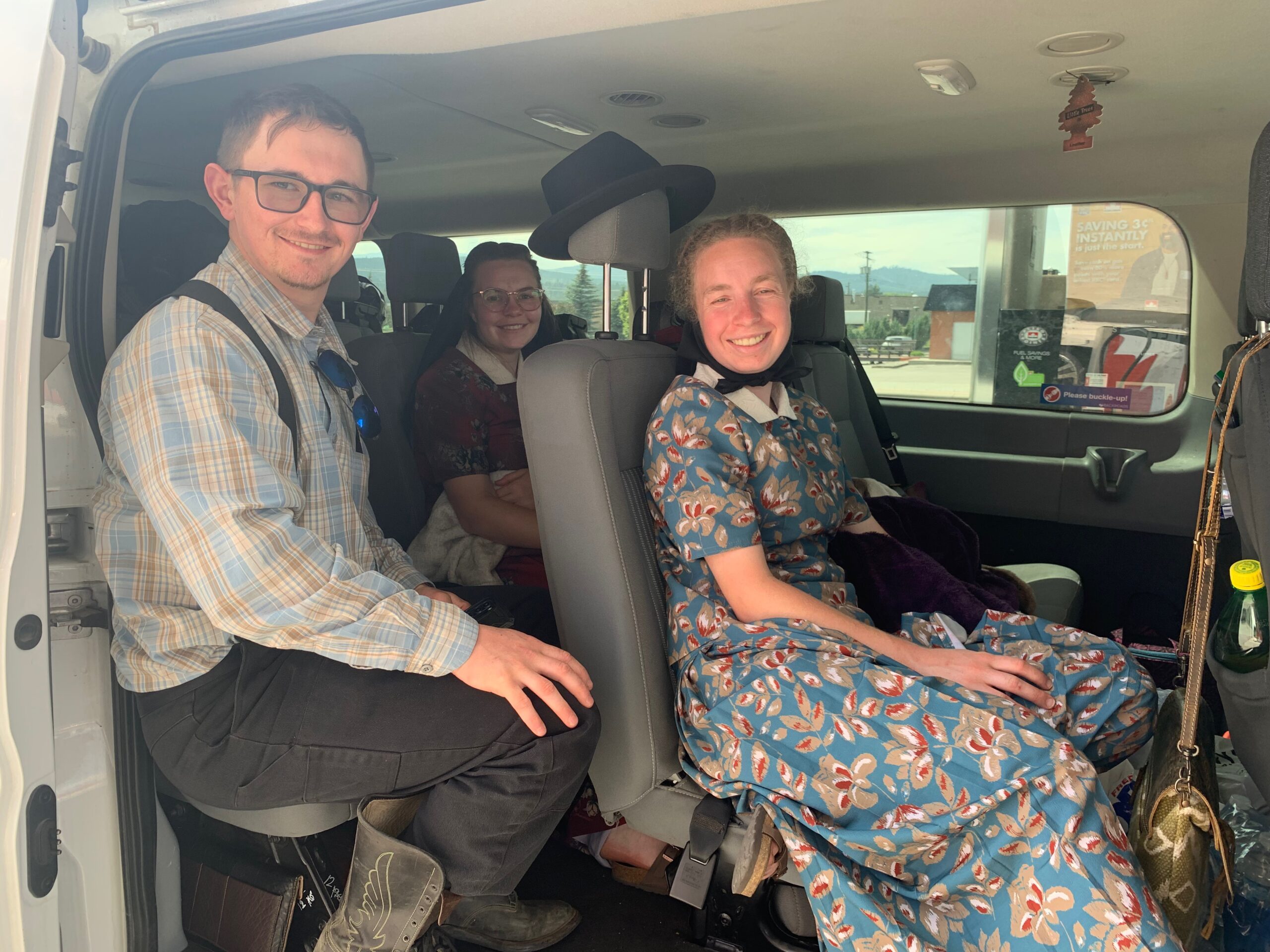
“Nice bike,” he says, drawing the word nice out long and slow as though savouring it. Thanks I say, do you ride? “Just a 300, just around the farm. Nothing like this,” he says. “But I’d like to one day.” His name is Willian and we talk a bit about what I’m doing and I ask him about the farm. “Twelve thousand acres, north of Edmonton,” he says. I think he said they had some cattle and sheep and also grew crops but I was so stunned at the size of the farm that I didn’t write that bit down.
He had come over to me from a transit van that was at one of the gas pumps. I gave him one of my cards and a Tip2Top sticker and, as some women emerged from the station shop and were walking over to the van, he ambled off thanking me. The women wore head scarfs and long floral dresses. I followed them to the van and, after they got in the side door and were seated, I asked if I take a picture. Sure, they said, smiling. I spoke to the woman sitting nearest the sliding door. I asked if they minded me asking about them, they didn’t, and I said they looked a little like Amish.
“We’re Hutterites,” said the woman sitting nearest the door, just in front of William. Her name was Carol. She had a really big smile, bright eyes and was very unselfconsciously pretty. Her handshake grip was firm and strong and she looked me straight in the eye when we spoke. They had come all this way from north of Edmonton for a wedding and were now heading home. I asked her what defined their faith, how did it differ from, say, Catholicism or Protestantism. “We’re Anabaptists,” she said, adding “which means you only get baptised when you decide you are ready, even if you are in your 20s or 30s.”
I have very little experience of such people but did once know some Dippers in Wicklow. The name, which is maybe what other people called them rather than their own formal name, was derived, I think, from their practice of total emersion baptism, usually in a river. I knew some when I was in my early teens in Avoca and my memory of the women is that they were very, very shy and somewhat withdrawn. Not necessarily oppressed (though they may have been) but just withdrawn when out and about with their husbands, who tended in any way to mix more with other men more than with their women folk. But Carol and the others (there was at least one other woman in the van and one other man) were vivacious, smiling and very, very outgoing. I’d love to have spoken to them longer but standing at a gas station pump isn’t ideal for interviews.
My resumed journey took up along Highway 93, more or less straight north towards where I would turn into the Rockies at a place named Radium Hot Springs, which sounded like a place best avoided. But the weather was closing in, the skies darkening and clearly rain was on the way. I stopped at Fairmont where there was a good campground and got the tent up within minutes of the downpour. There was no point in even trying to cook dinner so I satisfied myself with beer and peanuts sitting in the tent, before going to sleep.
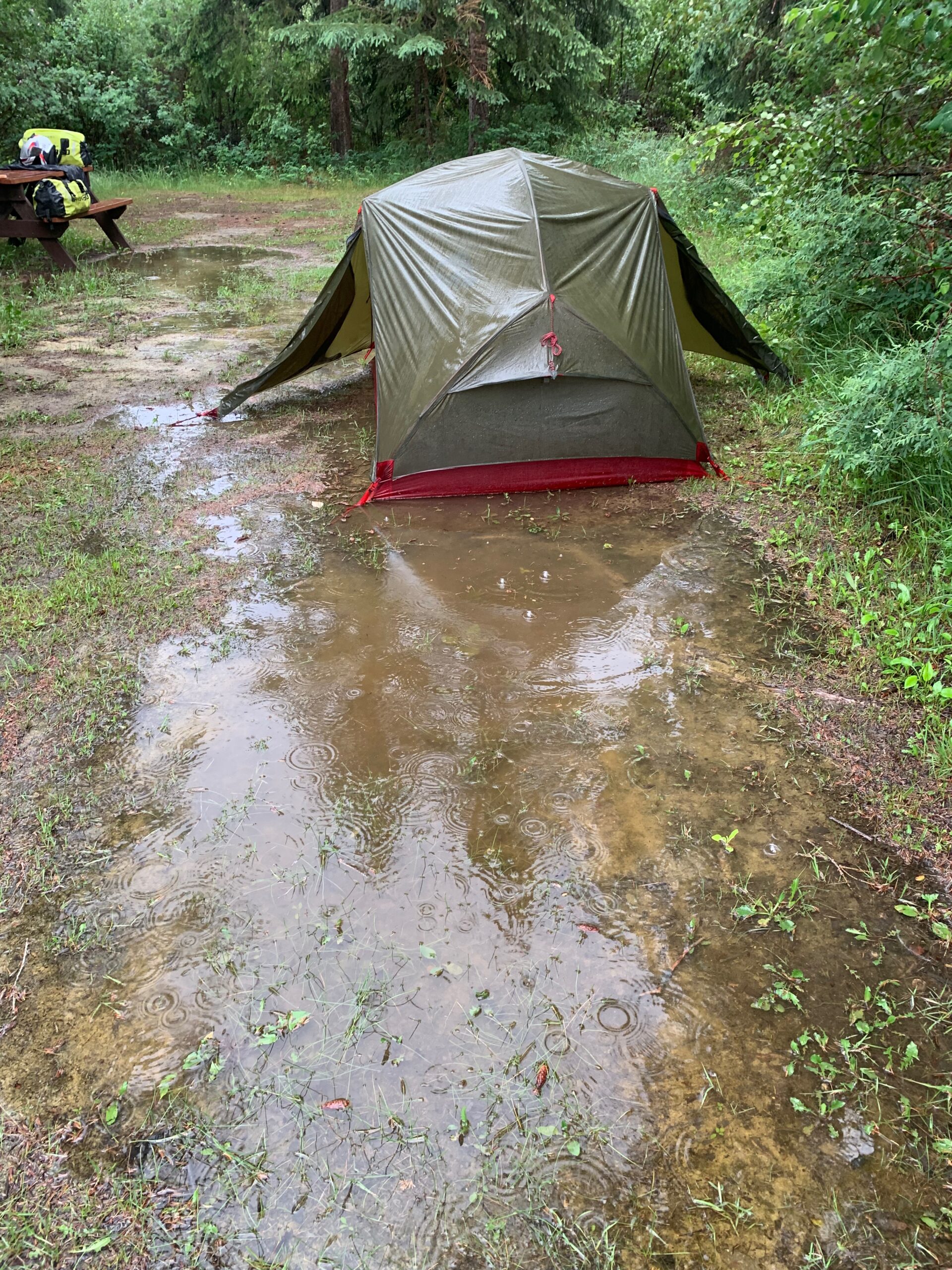
I awoke next morning to find at least two inches of water sloshing against the sides of tent groundsheet. The tent, an MSR hubba hubba NX, is the most costly item I have with me, after the bike, my laptop and phone, but is worth every penny. Hardly a drop of water got inside.
It took a bit longer than usual to get going, trying to dismantle and pack everything in a flooded site with intermittent rain but I did eventually and came to the famed Radium. A strangely Germanic place with hotels named Tyrol and The Old Saltzburg. I kept on going.
Highway 93 cuts deep into the Rockies via a very narrow, high sided gorge at Sinclair Creek, immediately outside Radium, and later follows the course of the Kootenay River, threading a way between the steep-sided mountains of Rockwell, on one side and Hawk Ridge on the other — more vistas, more epic scenery. Just before entering Banff National Park, it passes Marble Canyon, truly a wonder of the natural world. What today are the Rocky Mountains used to be a warm, shallow tropical sea in which the bodies of small creatures fell to the bottom when they died and gradually amassed into limestone — in the same way limestone was formed in Ireland. That was 500 million and more years ago. About 80 million years ago, the earth’s tectonic plates began moving in ways that pushed, buckled, bent and twisted that flat limestone into huge angular mountains. Finally, several periods of glaciation occurred from about two million to 15,000 years ago, and ice sculpted much of what we see today. Among the features are corries, bowl shapes scooped out of the sides of mountains and usually filled now with lakes, glacier carved U-shaped valleys and hanging valleys, ordinary river valleys that got cut in half by a glacier and, when the ice has melted, are left suspended, a valley running into a another at right angles, and half way its side. In the course of these processes, horizontal beds of rock are upended into the vertical and the elements start to attack the weak points, which are the joints between the layers of what was once sediment. Marble Canyon is the most dramatic and graphic display of this I’ve ever seen.
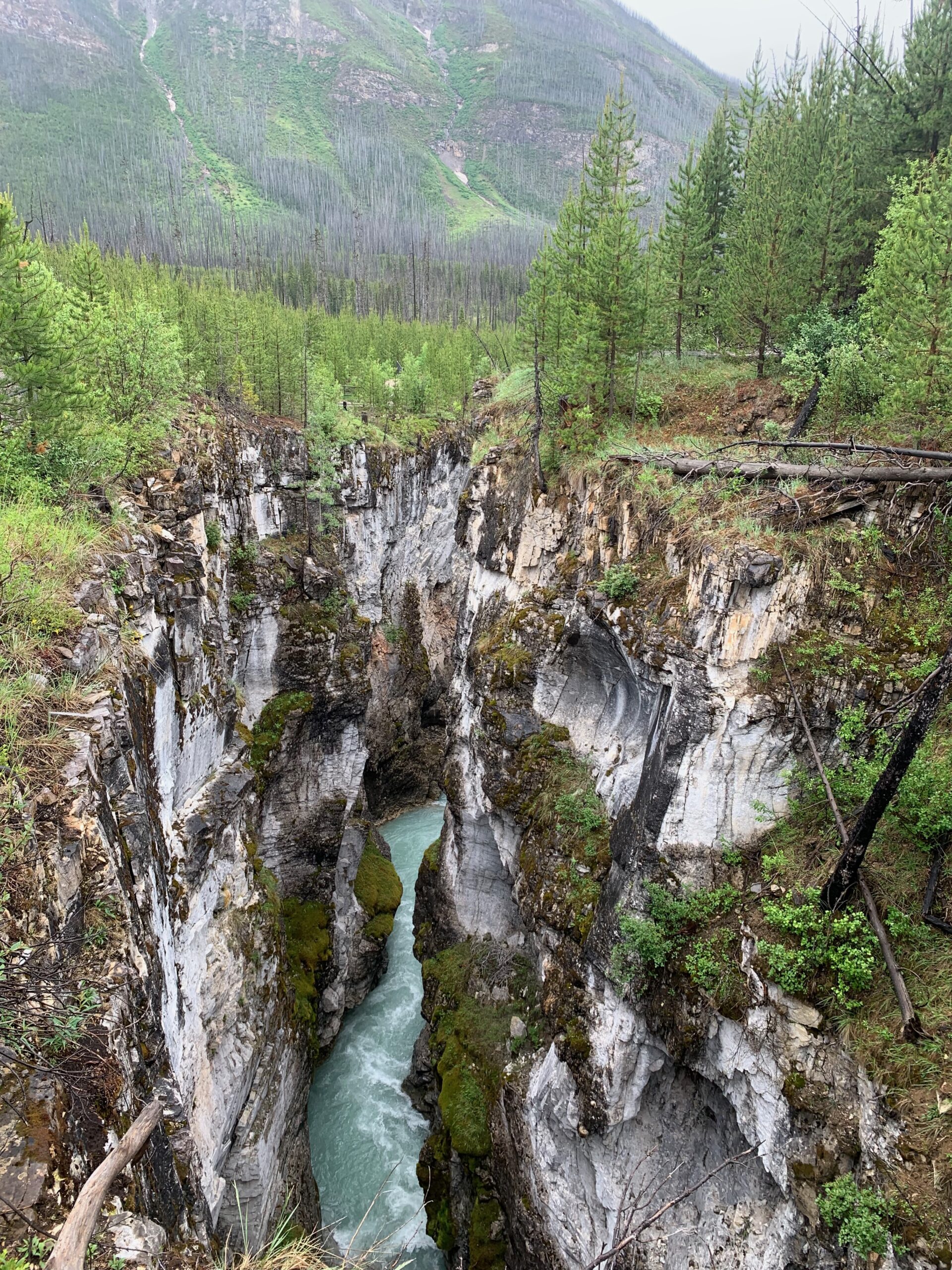
Vermillion is a glaciated U-shaped valley. Running into it at right angles is Prospector’s Valley, which was also glaciated but much less vigorously than Vermillion Valley. Prospector Valley was thus left hanging above Vermillion Valley and, as its glacier retreated, melt waters tumbling off it started drilling through the limestone at Tokumm Creek, attacking the rock at its weakest point, a joint. The result is the most extraordinarily deep but very narrow gorge in which a roaring torrent of water is constantly deepening the fissure, and scalloping great bowl shapes out of the side walls. It is extremely dramatic and also beautiful to look at, while also terrifying at the start, where the river waters make their first plunge with a roar as the water bursts onto the rocks below.
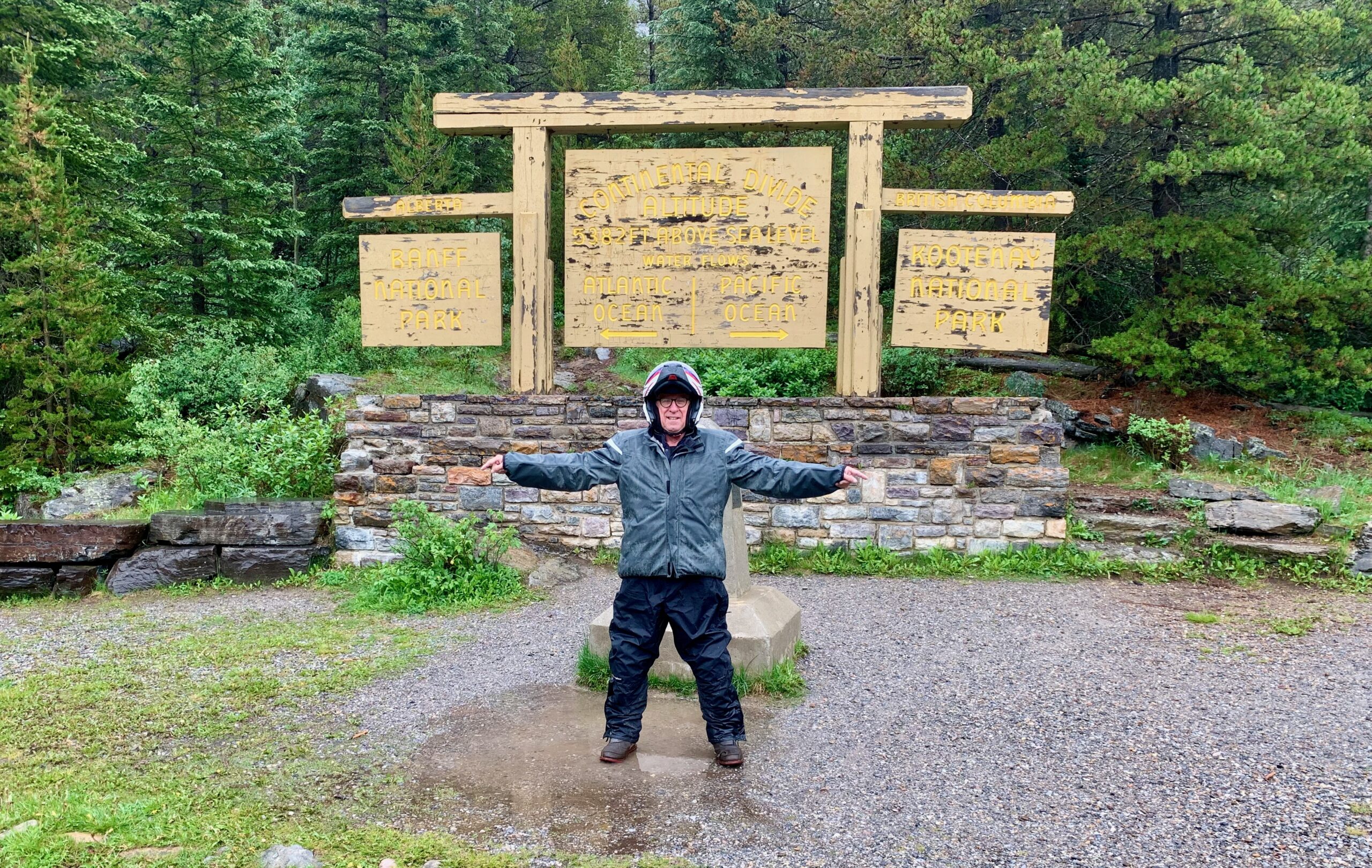
A little further on, the road crosses the Continental Divide — a single spot, a line running roughly north/south, in the Canadian Rockies. All water falling on one side of the line, the east side, will eventually reach the Atlantic Ocean, while all water falling on the other side, the western side, will one day reach the Pacific. You can stand there, as I did, one foot, my right foot, on the Atlantic side, the other, my left, on the Pacific side.
Just after Marble Canyon, I come to Castle Mountain Chalets, which has a gas station and shop. Hot chocolate! The young woman behind the counter was very chatty.
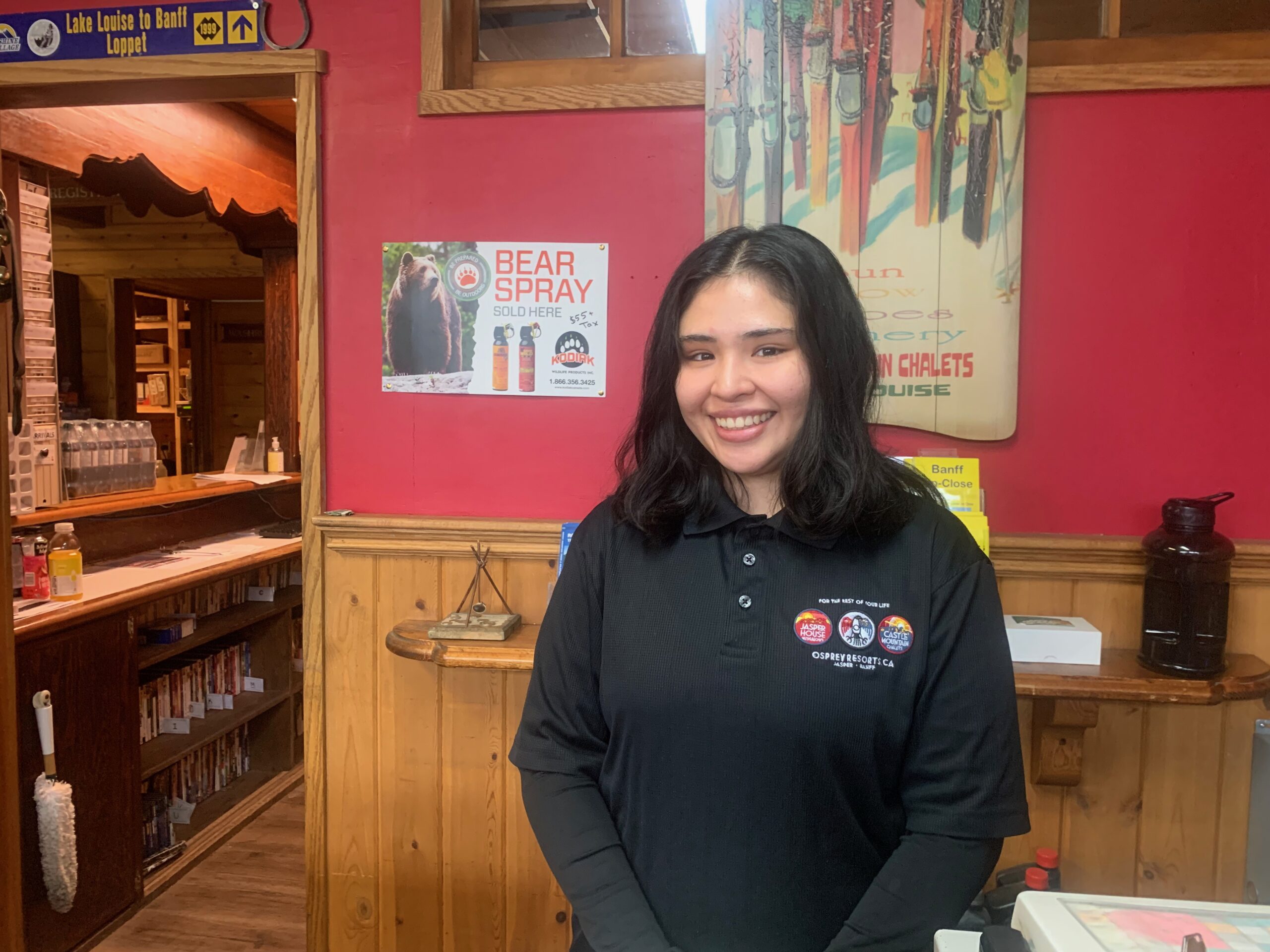
Where are you from, she asked me. I told her and asked where she was from. Calgary, she said, and then added: “My Dad’s from Honduras and my Mom is indigenous.” It’s a combination that produced a very pretty young woman with a very charming personality. She asks me my name and I ask hers. “Tara,” she says, to which I say — “that’s very Irish, you know” and she says “Yes, and my other name is Patrick” and we both laughed.
The road comes down into the Bow River Valley, a major valley that traverses, south-east to north-west, Banff National Park, from Banff city right up to Jasper, south of which Highway 93 becomes the Icefields Parkway because of the number of glaciers that can be seen. And just as I enter, the heavens open again, low cloud and rain blocking out all the mountains and reducing vision to maybe 200 metres. To make it worse, it’s started to get really cold. Two days ago in Nelson, the temperature was in the mid-30s; now, I’d say here it was below 10 but over 5 degrees. Below five biking becomes painful for me. I passed the less-than-encouragingly named Mosquito Creek campsite and went on for maybe five kilometres, before turning back and camping there. I slept fully clothed, anxious as to just how cold it could get, at 4am say, but thinking “this is good training for Alaska”.
In the morning, the rain had gone and so too had the clouds and, as I emerged from the tent — BOOM! mountains that were completely hidden yesterday, were now suddenly visible, towering over the landscape and right up close.
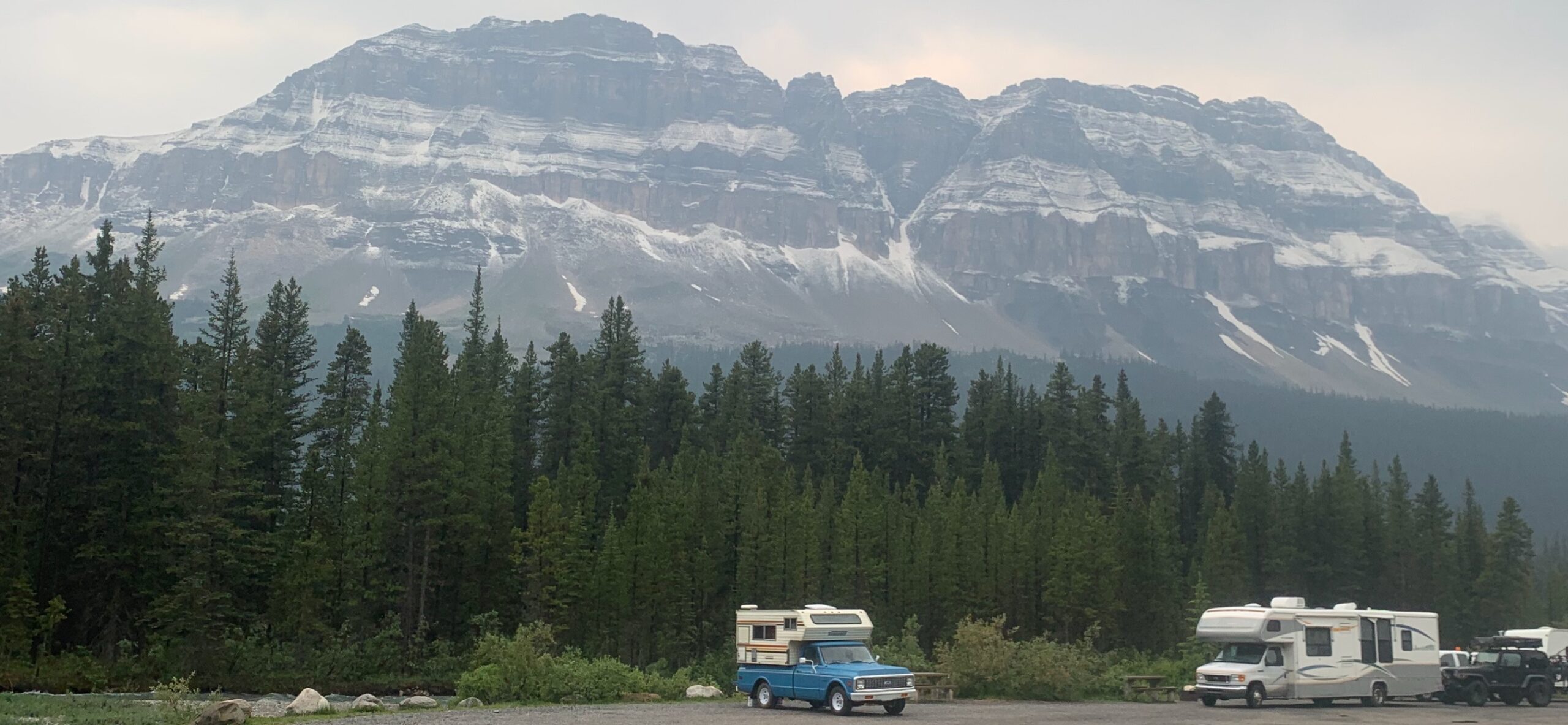
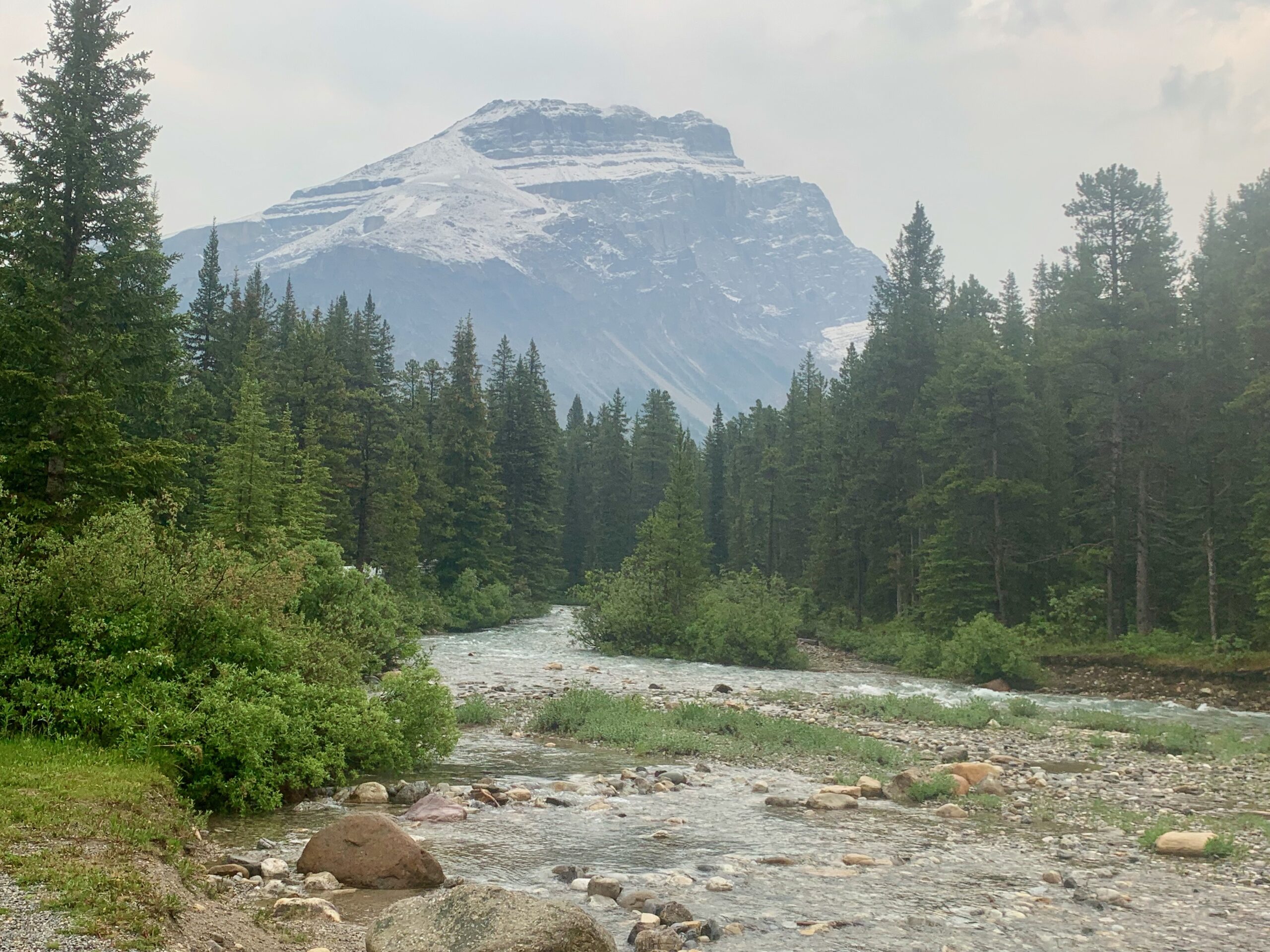
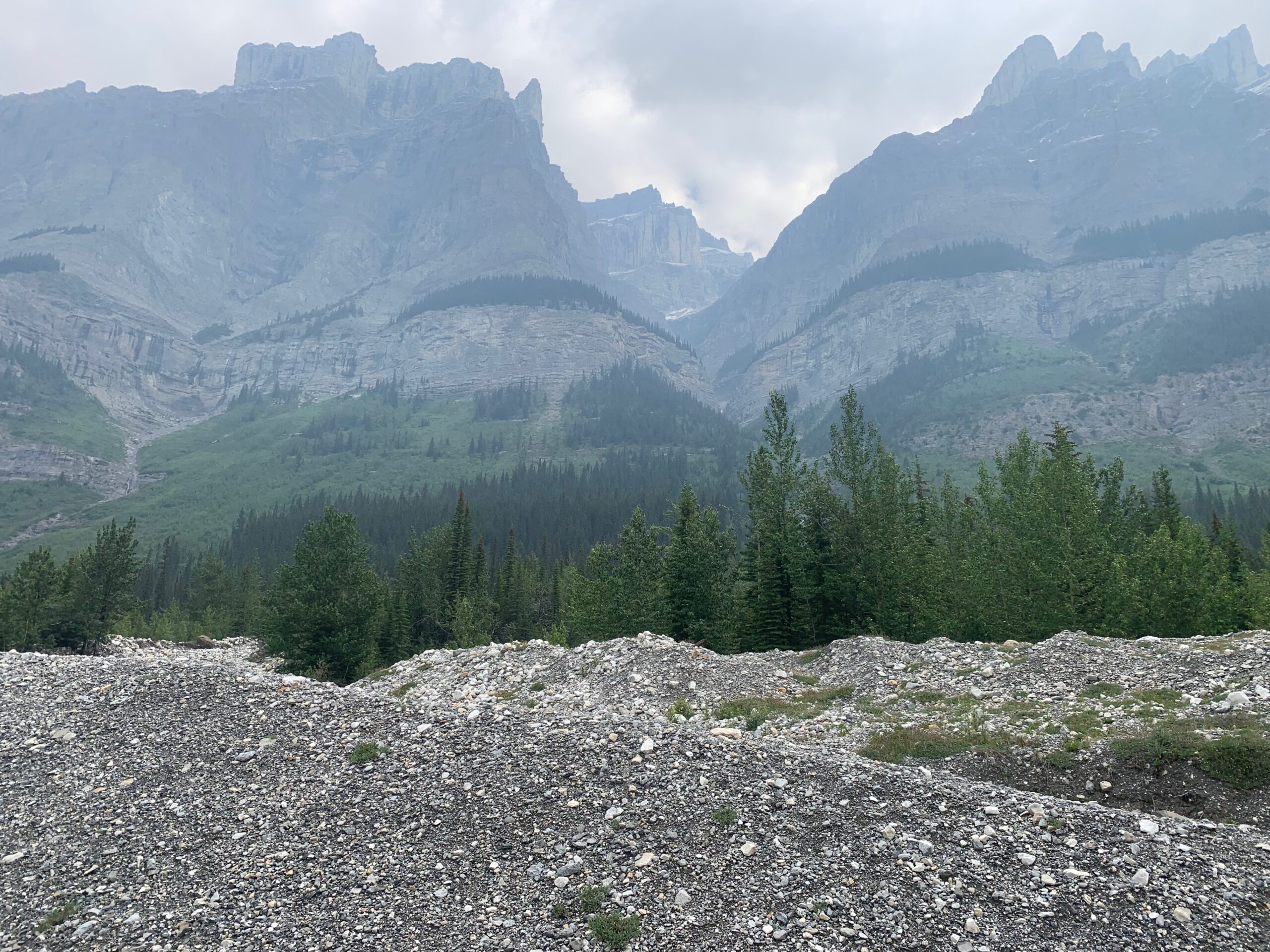
In the rain and the mist of yesterday, they had been invisible and, because I hadn’t looked at a map, I had no idea they were there. On the other side of the Bow River — here shallow and babbling over stones — stood Bow Peak and Crowfoot mountains, 2,867 meters and 3,050m respectively; and on the other side Mount Hector (3,394m). High but that that high, considering mountains of 4,000m and higher are two a penny in the Alps. But what makes these different is their bulk. They have a truly massive quality to them — vast pieces of bare rock, with glaciers visible and show picking out every tiny horizontal ledge of the limestone, highlighting layer upon layer upon layer, like the layers of a cake. Their visual impact is only slightly diminished by a blue-grey haze caused, I think by smoke from wildfires elsewhere in Alberta. When I look upon enormous creations of nature, such as this, or on down sweeping valleys covered in trees, with rushing rivers or lakes, still and reflecting everything around them, I feel a profound sense of calm. I’m fulfilled by just looking at what is before me.
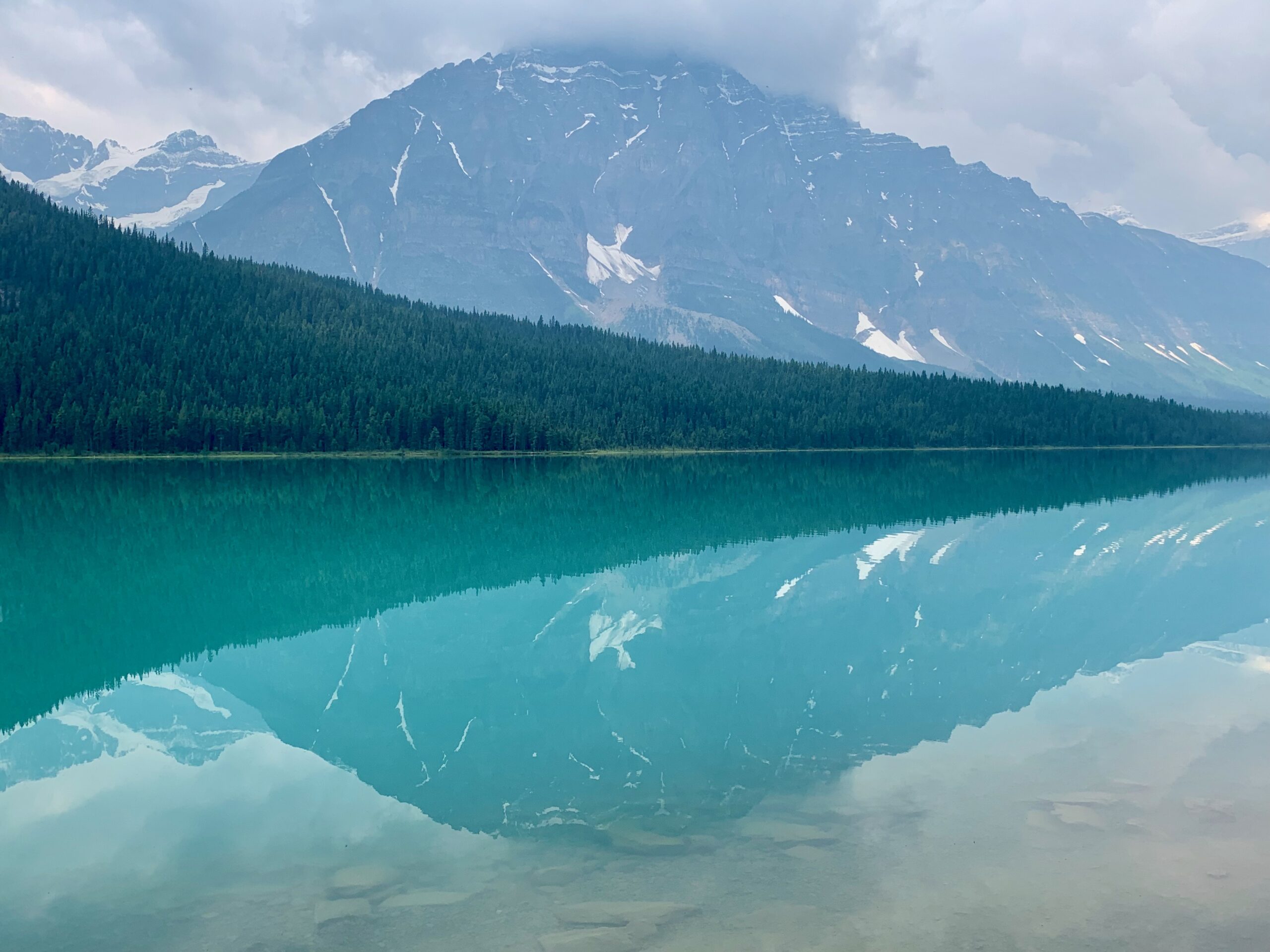
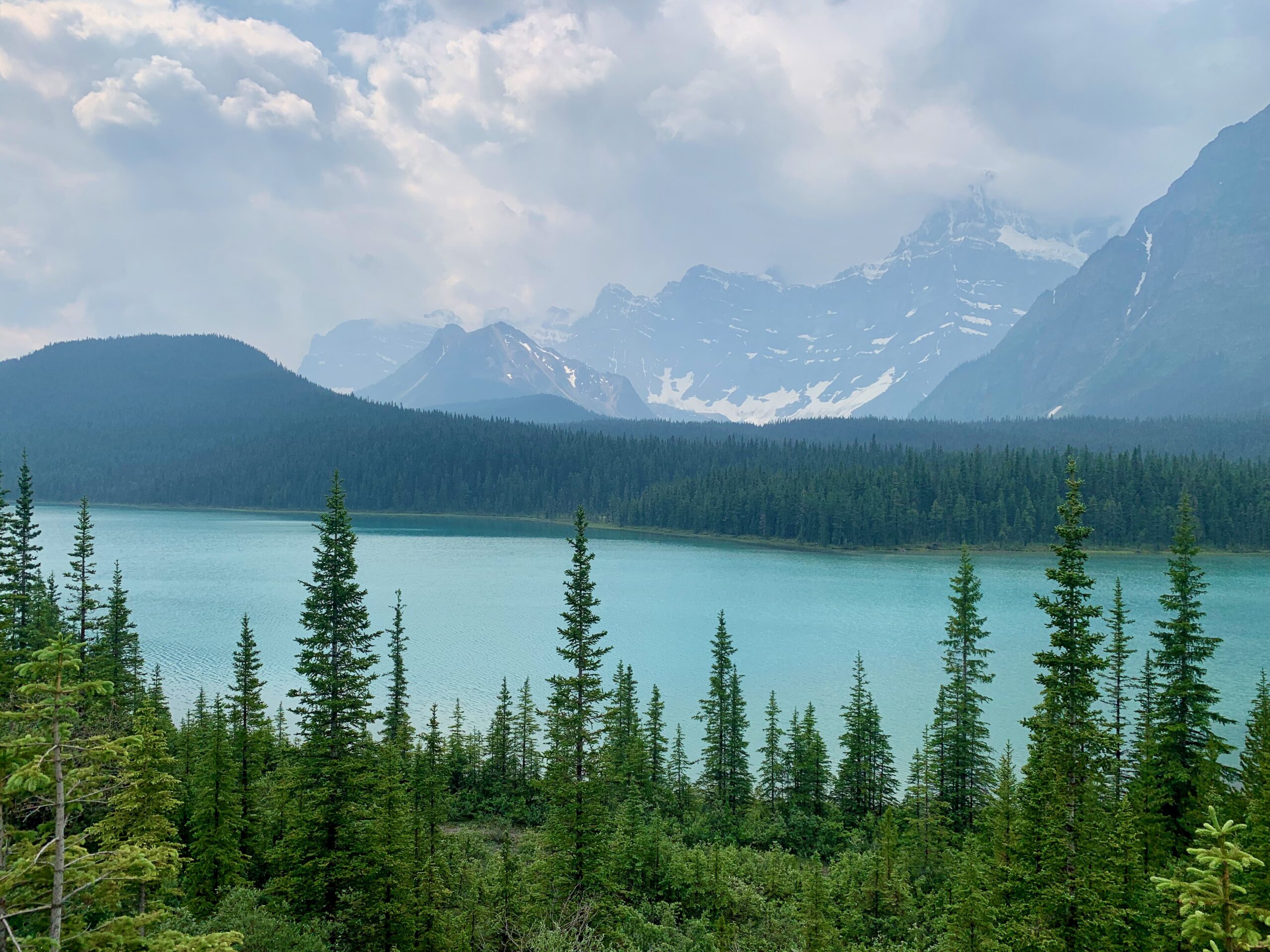
I got up quickly and rode on, eager to experience the fullness of this long, long valley before getting to Jasper . . . and before rain or low cloud, or both, spoilt the day. At Bow Lake and Waterfowl Lake, both a few kilometers on, the water was that milky blue colour I hadn’t seen since Torres del Paine and the Perito Moreno glacier in Patagonia, and the mountains behind them as dramatic and satisfying as anything I saw in the Andes.
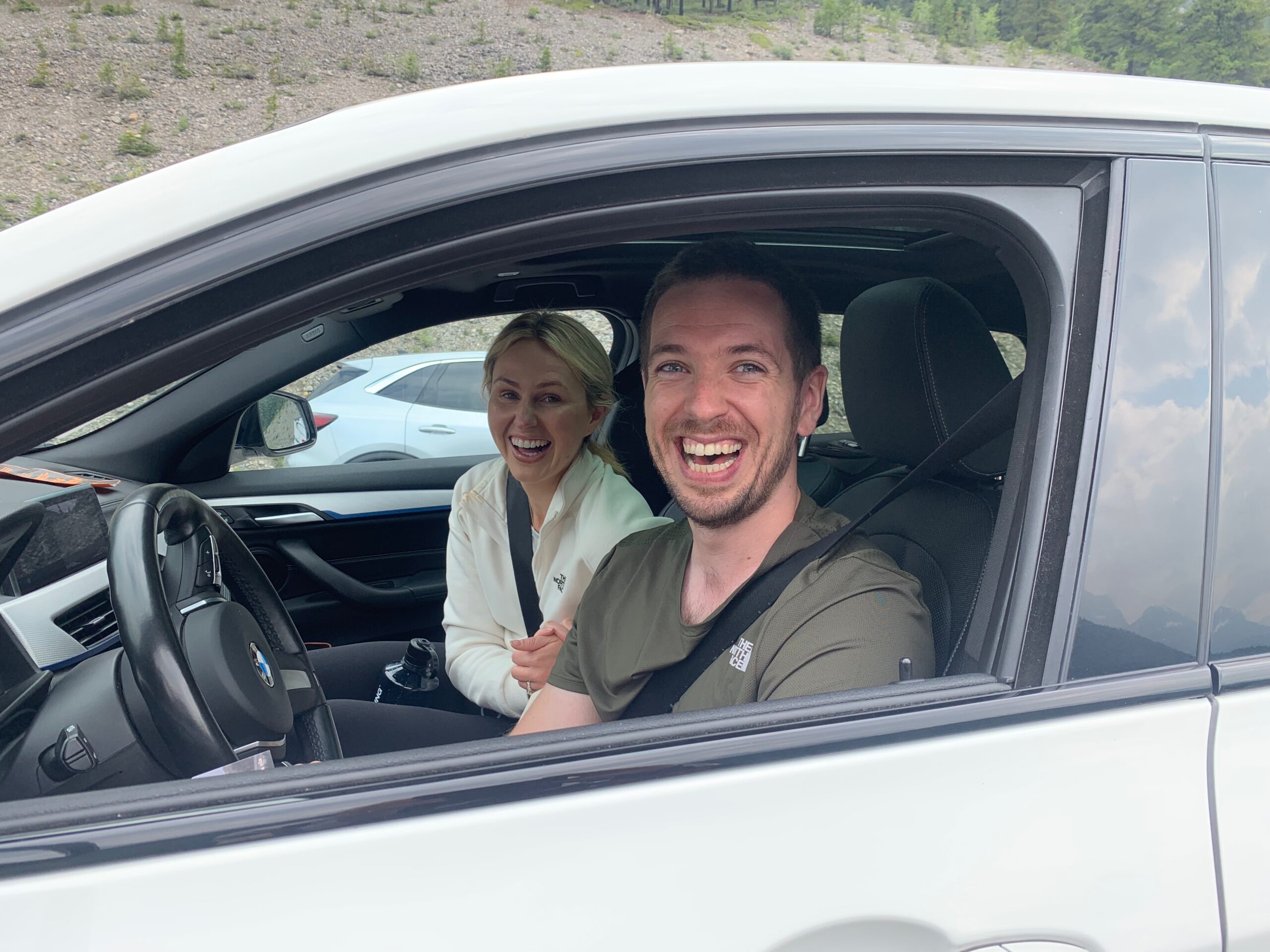
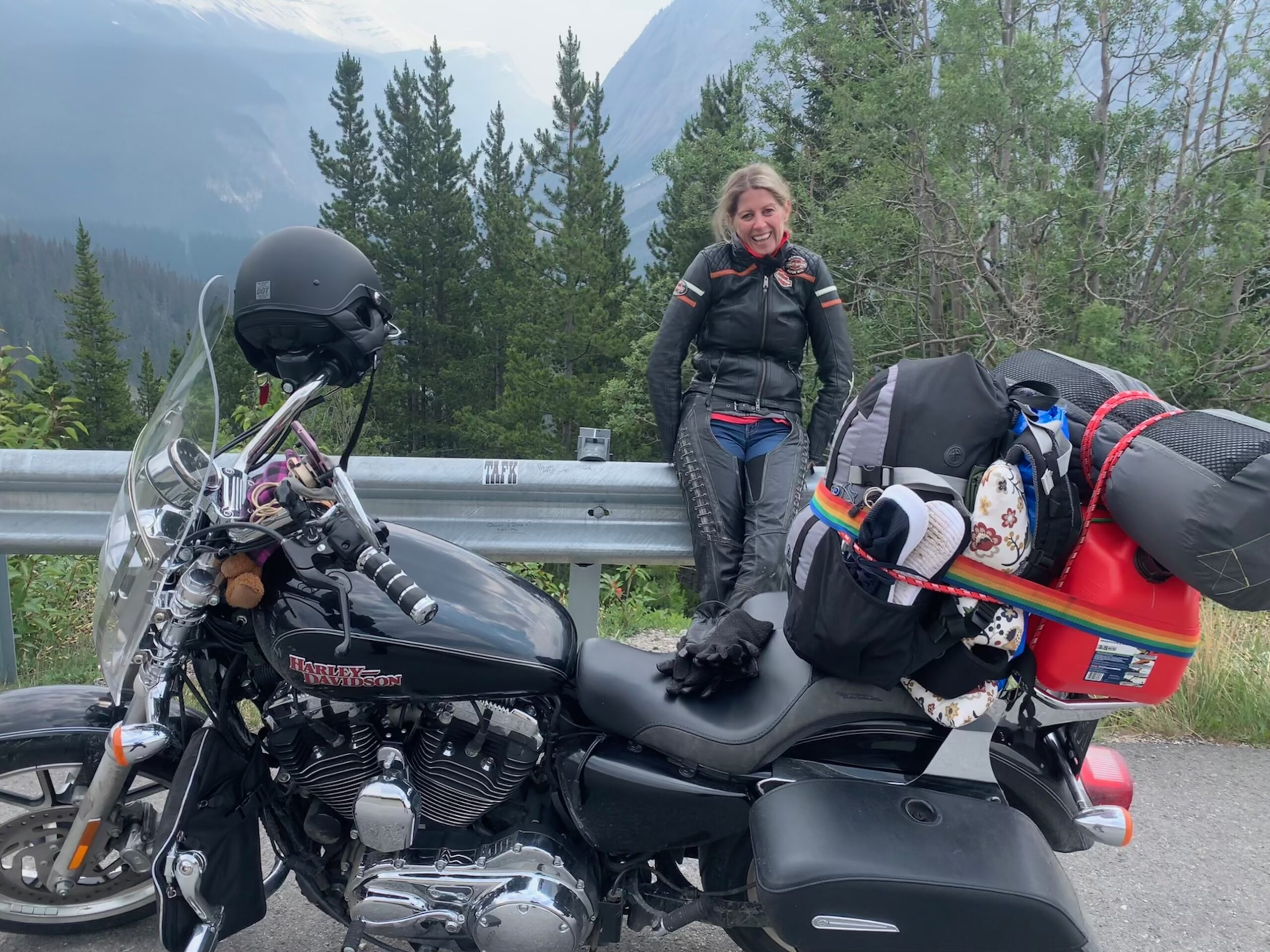
Incidentally, at Waterfowl Lake, I met Steve Curran and Emma Kinsella, from Cork, who were on their honeymoon. Just before starting the Icefields Highway, I came across Australian but Canada resident Nicky on her Harley. She used to work in Dublin, Nass and Tralee for Harvey Norman. Funny how this stretch of my journey is throwing up all sorts of Irish connections!
At Saskatchewan Crossing, where a turn to the right leads eventually to Calgary and Edmonton, there’s a gas station and restaurant and I’m desperate for a warm breakfast. I’m put at a table by a window with a fabulous view of the mountains and beside a very elderly couple in the corner. He is a little less robust than her, and she dotes on him.
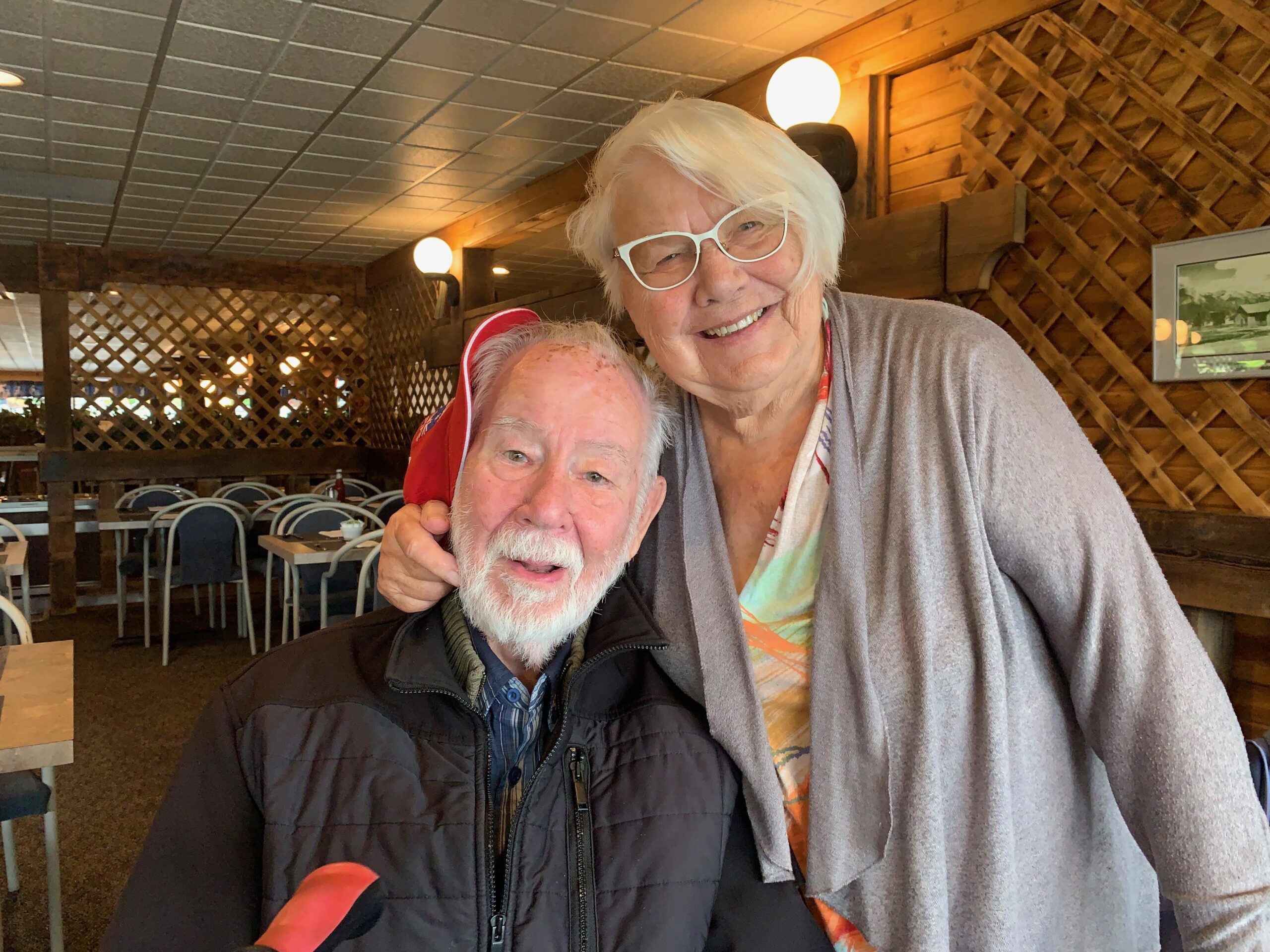
“Would you like more syrup with that dear,” she asks him.
“No, thank you, I’m doin’ fine,” he replies.
They talk in that tiny bit too loud way that elderly people sometimes do. It’s not that they want anyone else to hear what they’re saying. Maybe it’s just that they themselves are a little hard of hearing.
“Who’s going to drive today, dear?” she asks.
“Well,” he says, “I can do the first half and you can do the second. Or you can do the first half and I can do the second.”
“I’m happy with either,” she says.
And so they continue, between mouthfuls of breakfast and largely inconsequential but pleasant chat. Every now and then, a rogue swallow catches his throat unawares and he coughs and blows his nose. “I don’t know why it’s like this, this morning,” he says. “Well dear you were fine during the night but you were lying down then,” she says. I’m not sure what led up to this, but she pronounced at one point: “I suppose I can be Polish and I could be German but I’m so proud to be Canadian. I love this country” and there was also something about having been married for 70 years.
After a while, when my breakfast had arrived, I heard him say: “What are you riding?” I turned around and told him. “Ohhhhh,” he said, “I used to ride but that was a long time ago.”
A little while later, he got out of his chair, with her help, and holding his walking stick tightly, made his way to the rest room, slowly and with carefully judged measured paces. When he’d gone, she swung around to me and I could see her properly for the first time. She had a beautiful face and a lovely sparking smile. She was full of life.
“I envy you on a motorbike,” she said. “It’s lovely. He’s had two strokes but he’s still moving.”
Benita was born in Krakow, Poland, in the 1930s.
“Things were not good after the war,” she said, “and so by myself, aged 17, I came to Canada on a slow boat and then across Canada on a wooden seat on a train from St John’s Nova Scotia to Alberta where I was supposed to work on a farm.”
Instead, she worked in a hospital and, to save the 10 cent taxi fare to and from work, she walked. Vernon, he who had gone to the loo, and his brother ran a taxi business and she always refused his offer of a lift but eventually she accepted and they went out and got married, “70 years ago last September 10th”, she said.
“What are you writing all this down for,” she said to me. I told her why. “Oh,” she said dismissively but carried on. In Krakow, her father had driven a freight train but he died young, aged 55. She could remember her grandmother from back then, but not much more about that life. She remembered her grandmother feeding a goose and massaging its throat to help it swallow.
Vernon returned and pulled up a chair to join the conversation. “This getting old is better than the alternative,” he pronounced with slight weariness. His brother used to have a Harley-Davidson 45 — “no shiny parts, from the Army”, he said — “any kid that wanted one could have one” after the war. His brother was more into bikes than he was; the brother also had an Indian with a sidecar — “likely sold it for $50,” said Vernon, “don’t know what it would cost now”. (I checked: there’s one on eBay for $17,500.) Vernon’s big thing was cars. “I had a 39 Ford Coupe,” he said.
In the early 1950s when Alberta’s oil boom was starting, he worked in that before setting up the taxi business with his brother. “Until I met Benita and we decided to get married.” Then he worked for a hospital and then for a gas utilities company as an installer and all-purpose go to fix it man. When he retired, they bought a small sailboat and moved to Vancouver Island.
“We sailed it around and around,” said Benita, “and we loved it. Boy we loved it!”
They had five children, have five grandchildren and three great grandchildren as well. “They’re much more careful nowadays than we were,” Benita explained, apparently a reference to the low number.
She asked me was I going to do the Dempster Highway, the road that runs from Dawson City in the Yukon, north to the Arctic Ocean and the Northwest Territories. I said I might do some of it but I was committed to riding the Dalton Highway from Fairbanks to Deadhorse, in Alaska, and which is further north than the other.
“The Dempster Highway is lovely,” she said. “I [only] have to close my eyes to think of it. Lovely.”
And so they got up to leave — 90 year old Vernon and Benita, a sprightly 88. He picked up his walking stick in his right hand, while she linked arms with his left, and together, they walked slowly across the dining room.
“Now,” one of them said, “are you driving or am I?”
At the precise moment they were shuffling away from me, the restaurant sound system was playing Neil Young’s Harvest Moon.
But now it’s gettin’ late
And the moon is climbin’ high
I want to celebrate
See it shinin’ in your eye
Because I’m still in love with you
I want to see you dance again
Because I’m still in love with you
On this harvest moon
Because I’m still in love with you
I want to see you dance again
Because I’m still in love with you
On this harvest moon
I turned around again to look out the window at the mountains. But I couldn’t see them. Must have been something in my eye. . .
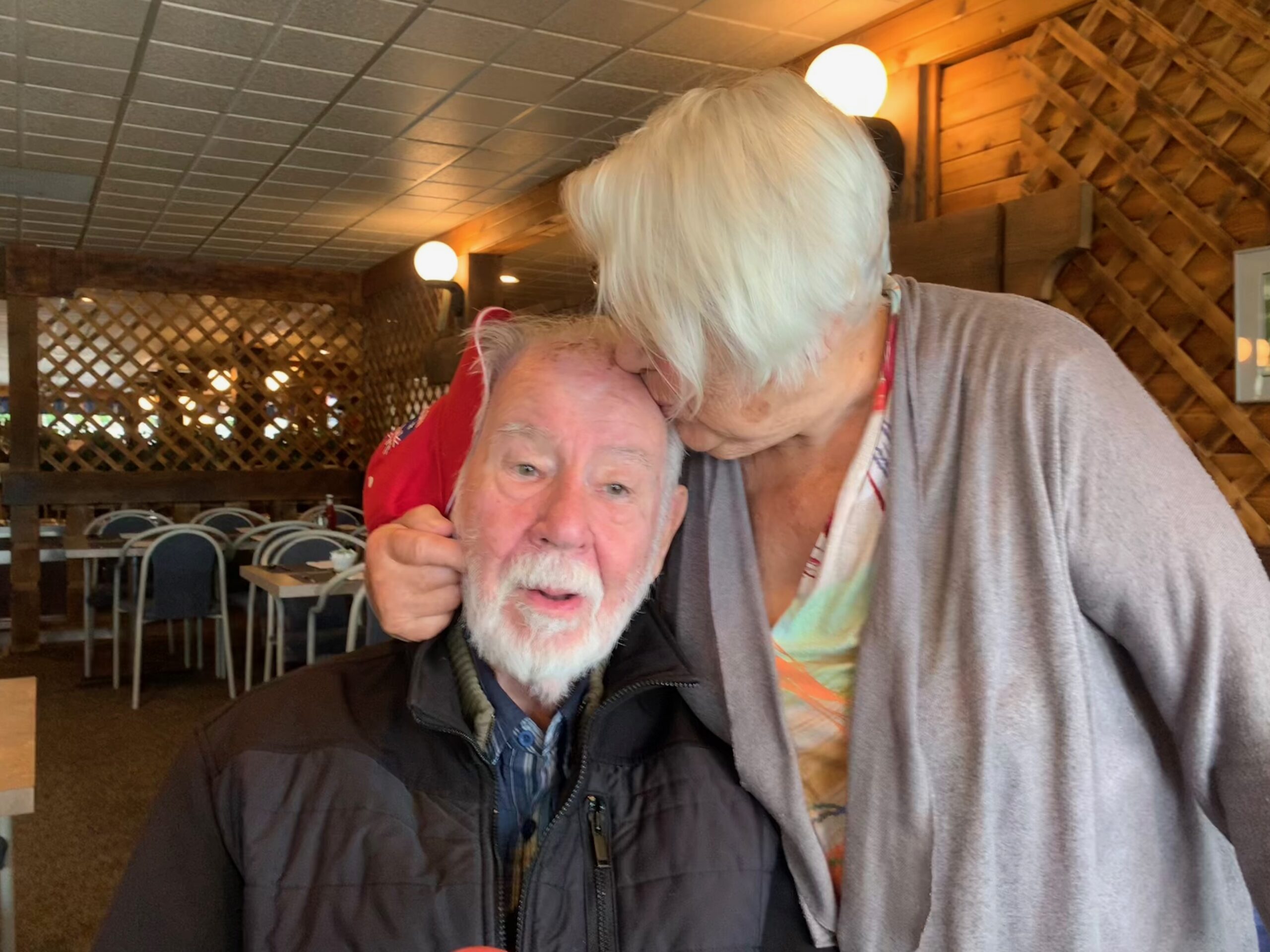
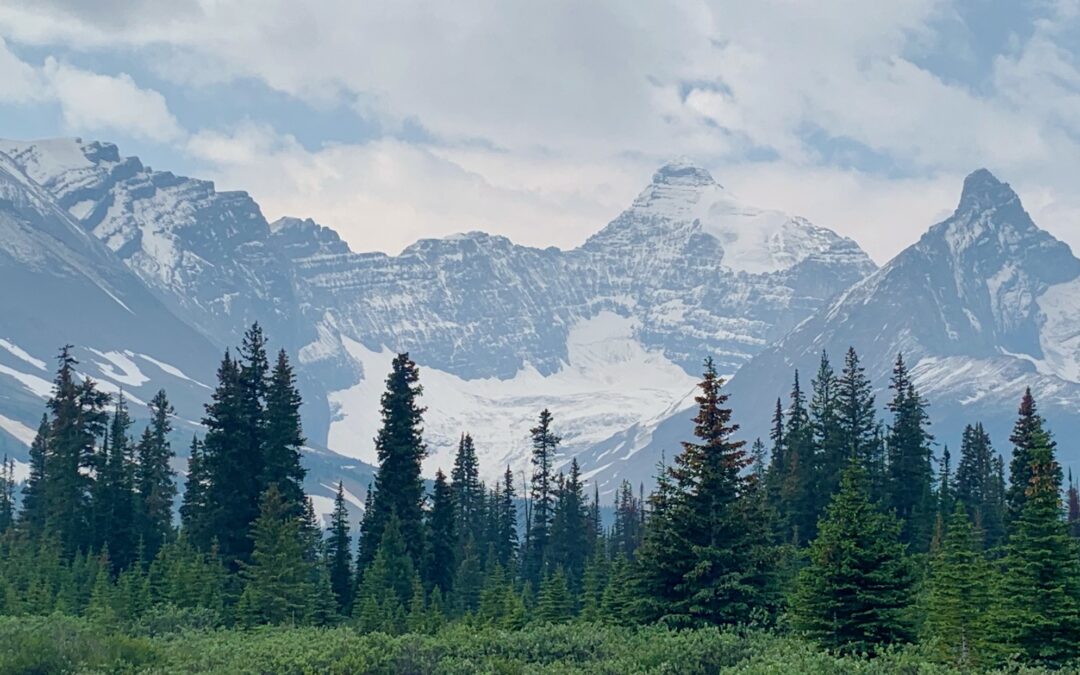
Lovely piece, Peter.
Lovely piece, chum.
A fantastic series of vignettes Peter. Just came across your journey for the first time today. We lived in Canada in the late 80s and you capture it so well in photos and words. Looking forward to reading more!
Ah, many thanks; that’s kind of you to say. I must say that I love Canada… not sure I could have left had I lived there in the ’80s!